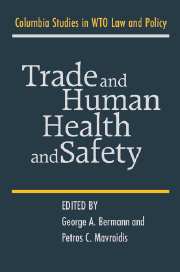Book contents
- Frontmatter
- Contents
- Preface to the Series
- Introductory Remarks
- 1 A Map of the World Trade Organization Law of Domestic Regulation of Goods
- 2 The WTO Impact on Internal Regulations: A Case Study of the Canada–EC Asbestos Dispute
- 3 Reflections on the Appellate Body Decision in the Hormones Case and the Meaning of the SPS Agreement
- 4 The Salmon Case: Evolution of Balancing Mechanisms for Non-Trade Values in WTO
- 5 Lotus Eaters: Reflections on the Varietals Dispute, the SPS Agreement and WTO Dispute Resolution
- 6 Regulatory Purpose and “Like Products” in Article III:4 of the GATT (with Additional Remarks on Article III:2)
- 7 The WTO Standard of Review in Health and Safety Disputes
- 8 Expert Advice in WTO Dispute Settlement
- 9 Domestic Regulation, Sovereignty and Scientific Evidence Requirements: A Pessimistic View
- 10 Time for a United Nations' “Global Compact” for Integrating Human Rights into the Law of Worldwide Organizations: Lessons from European Integration Law for Global Integration Law
- Index
2 - The WTO Impact on Internal Regulations: A Case Study of the Canada–EC Asbestos Dispute
Published online by Cambridge University Press: 27 July 2009
- Frontmatter
- Contents
- Preface to the Series
- Introductory Remarks
- 1 A Map of the World Trade Organization Law of Domestic Regulation of Goods
- 2 The WTO Impact on Internal Regulations: A Case Study of the Canada–EC Asbestos Dispute
- 3 Reflections on the Appellate Body Decision in the Hormones Case and the Meaning of the SPS Agreement
- 4 The Salmon Case: Evolution of Balancing Mechanisms for Non-Trade Values in WTO
- 5 Lotus Eaters: Reflections on the Varietals Dispute, the SPS Agreement and WTO Dispute Resolution
- 6 Regulatory Purpose and “Like Products” in Article III:4 of the GATT (with Additional Remarks on Article III:2)
- 7 The WTO Standard of Review in Health and Safety Disputes
- 8 Expert Advice in WTO Dispute Settlement
- 9 Domestic Regulation, Sovereignty and Scientific Evidence Requirements: A Pessimistic View
- 10 Time for a United Nations' “Global Compact” for Integrating Human Rights into the Law of Worldwide Organizations: Lessons from European Integration Law for Global Integration Law
- Index
Summary
Introduction
The WTO is facing increasing criticism. This was highlighted during the third ministerial meeting in Seattle, where massive street protests disrupted the conduct of the conference. Apart from demonstrations, a series of groups used the Seattle ministerial meeting to articulate a range of views on the future of the trading system, in most cases far more subtle than a blanket or dogmatic rejection of globalisation or even the WTO. Non-governmental organisations and public policy-makers from all over the world met to analyse WTO policies and their potential impacts. Amongst the most common criticisms was the WTO's alleged role in impeding national governments from granting adequate protection to the environment, or addressing consumer interests and national health and safety concerns.
Different understandings concerning the extent to which WTO rules constrain domestic regulatory autonomy have manifested themselves in recent high-profile trade controversies. In the famous Beef Hormones case, the USA successfully challenged the EC's ban on beef injected with natural and synthetic growth hormones. The regulatory measure in question had been adopted in a response to European consumers' concerns about potential health effects of such hormones being present in foodstuffs. Similarly, in the case of genetically modified organisms (GMOs), European consumers' reluctance towards genetically modified foods triggered the European institutions to adopt detailed regulations regarding risk assessment, release authorisation, subsequent monitoring and labelling of GMOs. The WTO consistency of this regulatory framework was repeatedly the subject of controversy in the TBT Committee.
- Type
- Chapter
- Information
- Trade and Human Health and Safety , pp. 77 - 117Publisher: Cambridge University PressPrint publication year: 2006
- 6
- Cited by



